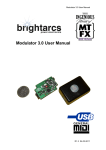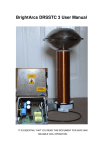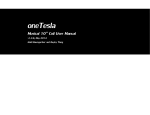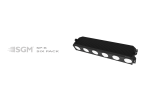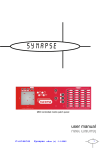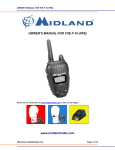Download DRSSTC 4.2 User Manual
Transcript
DRSSTC 4.2 User Manual IT IS ESSENTIAL THAT YOU READ THIS DOCUMENT FOR SAFE AND RELIABLE COIL OPERATION. REV 1.2 21/11/2010 DRSSTC4.2 User Manual Contents: Contents:................................................................................................................... 1 Product Description: .................................................................................................. 2 Parts Included: .......................................................................................................... 3 Coil Assembly: .......................................................................................................... 4 Coil location: ...................................................................................... 4 Breakout point: ................................................................................... 5 Cable connections:............................................................................. 6 Modulator connections: ...................................................................... 7 Safety and Operating Considerations: ....................................................................... 8 Essential operating guidelines: ........................................................... 8 Electrocution risks: ............................................................................. 8 Interference and damage to electronics:............................................. 9 Fire hazards: ...................................................................................... 9 Health hazards: .................................................................................. 9 Legalities: ......................................................................................... 10 Coil Operation: ........................................................................................................ 11 Essential checks before operating: ................................................... 11 Essential tests before applying modulation:...................................... 11 Considerations for extended operation: ............................................ 12 Maintenance: ................................................................................... 12 Trouble Shooting: .................................................................................................... 13 If a flash-over is observed: ............................................................... 13 Arcing at the torroid interface: .......................................................... 14 Power supply fault indications: ......................................................... 14 Tuning: ............................................................................................. 14 Guarantee: .............................................................................................................. 15 It is advised that you read and understand all aspects of this manual before use. Improper use of the device may cause personal injury, death, fire or criminal proceedings. Brightarcs can not be held responsible for any resulting losses as a result of using their product. The user is solely responsible for the safety of themselves and others, it is essential that they read and familiarise themselves with this document. 1 DRSSTC4.2 User Manual Product Description: Brightarcs DRSSTC 4.2 is a musically modulated highly advanced double resonant solid state tesla coil. This section briefly summarises how the device works. Tesla coils operate using the phenomenon of electrical resonance in which energy is transferred between magnetic field storage and electric field storage. In the case of the secondary, the magnetic field is created around the solenoid coil of the secondary windings and the electric field is stored as charge on the capacitance of the round torroid (see Figure 1). The resonance occurs at the secondary resonant frequency. The primary winding resonates with a separate large capacitor located within the power supply at the primary resonant frequency. The primary circuit is driven at its resonant frequency causing energy to accumulate in the circuit. This circuit is coupled by transformer action to the secondary and in turn drives the secondary circuit at the same frequency. If the two frequencies are similar then large voltages are induced on the torroid, causing the air around it to undergo electrical break-down. The resonant frequency of the secondary drops as the plasma formed by the break-down of the air forms a streamer. The primary frequency is tuned to slightly below the secondary and this frequency gap reduces the chance of breakdown. When breakdown does occur, the streamer growth lowers the secondary resonant frequency and the gap decreases causing much higher voltages on the secondary. This ensures maximum energy is delivered to the streamer, resulting in a longer arc forming between the torroid and the surroundings. The breakdown of the air causes rapid heating of the region around the streamer. This causes sudden thermal expansion resulting in a loud noise in the same way thunder is caused. The power supply allows reproduction of the breakdown many times per second and this allows a musical tone to be played. For example, breaking down the air 440 times per second causes the musical note 'A'. The modulator changes the breakdown repetition rate and intensity to recreate the musical input. The modulator can only try to approximate the musical input since the output will always be a pattern of loud 'clicks' caused by the breakdown events. Brightarcs has created the DRSSTC4.2 as a simple and robust way to demonstrate a musical DRSSTC. 2 DRSSTC4.2 User Manual Parts Included: The DRSSTC4.2 is supplied as the 8 components shown in Figure 1. If any of these components is not included in the packaging then contact Brightarcs. Figure 1. Coil components The kit consists of: 1 x Torroid of light weight aluminium ducting and polystyrene. 1 x Trolley of light weight MDF and plywood construction on plastic castors. 1 x Pre-assembled primary and secondary coil combination. 1 x DRSSTC4.2 power supply. 1 x 5m switched IEC cable with UK plug socket (unless alternative requested). 1 x 10m digital optical cable. 1 x Digital modulator, cables and batteries*. 3 x Breakout points of 2mm copper wire. 1 x Documentation pack. The parts supplied should not be exchanged for other similar parts because this could create a fire or electric shock risk. The next section covers assembly of the coil components. * The modulator is under continuous development and a separate document will contain a detailed description of the modulator version supplied. 3 DRSSTC4.2 User Manual Coil Assembly: Coil location: Setting up the tesla coil has been made as easy as possible by the modular construction. Choose a location clear from any objects which could catch fire or be damaged by the coil. Ensure that the ceiling is 3m or more from the floor and that there no sharp objects close to the base of the coil. If the coil is operating outdoors then ensure there is no chance of rain reaching the coil. If the coil is operating indoors then adequate ventilation must be present. Assemble the coil, torroid and power supply onto the trolley, taking care to observe the clearances required for safe operation (Figure 2). The assembly should look like Figure 3. The torroid is marked to show which side must be downward facing. Figure 2. Required clearances for operation Figure 3. Correctly assembled coil on the trolley 4 DRSSTC4.2 User Manual The operator should ensure the coil is stable and that there are no strong gusts of wind or other causes for the coil to topple over. Do not place the coil in fire escape routes or adjacent to doors which might be opened. It is recommended that a plastic barrier be used to protect any observers from the coil. It is the operator's responsibility to ensure that all potential risks are assessed before turning the coil on. A sample risk assessment can be obtained from Brightarcs. Breakout point: The coil must be operated with a breakout point since this effectively limits the stresses experienced by the insulation between the primary and secondary windings. Operation without a breakout point will lead to unpredictable behaviour and destructive flash-overs which will destroy the windings. Suitable wire breakout points are supplied and one or more should be positioned on top of the torroid pointing outwards as shown in Figure 4. The breakout points can be used to direct the streamers in a way that gives a better plasma display from the coil. More breakout points create shorter arcs but offer superior audio performance. Figure 4. Correct breakout point orientation 5 DRSSTC4.2 User Manual Cable connections: The power supply has several connection points and indicators detailed below. Figure 5. Front of power supply Figure 6. Rear of power supply Part Description Power inlet IEC power inlet 220-240 VAC 50/60Hz. Only use the power cable provided. Optical input Connection to the modulator via optical cable. Only use the fully unwound plastic cable provided (Note: Not SPDIF). Over current breaker Thermal over current circuit breaker. The insert pops out in the event of over current. Do not reset with power connected. Power indicator Green LED to indicate the main board has power. Fault indicator Red LED to indicate input surge, under voltage, over temperature and over current. Medium voltage output High frequency coil output at ~340 VAC. Connect to the primary lead without silicone insulation reinforcement. High voltage output High frequency high voltage coil output ~12 kVAC. Connect to the primary lead with silicone reinforcement. Earth connection Connect to the secondary earth lead. Enclosure is earthed. Heat sink The heat sink to cool the power transistors and enclosure base. Serial number The power supply serial number. Enclosure Note: Opening the enclosure will void the warranty. Table 1. Power supply parts summary 6 DRSSTC4.2 User Manual Connect the wires for the power supply, primary winding, earth connection and optical lead input as detailed in Figure 7. Take care to ensure the primary winding connection with the extra insulation goes to the terminal marked ‘high voltage’ and that the power lead is not connected to the mains during assembly. Figure 7. Wiring connections of the power supply Connect the plug side of the IEC power lead to a 230V (220V - 240V) socket and the modulator to the other end of the optical cable. In many cases it is desirable to use an extension cable, if this is the case then fully un-wind the cable to avoid it overheating. The coil is now ready to operate once the pre-checks and tests have been completed. These are covered in the coil operation section - ensure you read and comply with the safety guidelines. Modulator connections: The modulator is under continued development and the most up to date version will be shipped with the coil. This section summarises the function of the modulator. A more detailed description will be given in the modulator manual. The modulator connects to the end of the optical cable and consists of a microprocessor with an interface to the source of the modulation and an optical output to the coil. The interface may be one or more of the following: • Low impedance audio - Sound card line-out / headphone output • High impedance audio - Guitar or dynamic microphone levels • MIDI input - Standard MIDI signal levels • USB/MIDI input - USB MIDI interface In addition, the modulator will have a 'test mode' used to check for correct coil operation before applying full power in order to prevent problems with flash-over and other unpredictable operation. 7 DRSSTC4.2 User Manual Safety and Operating Considerations: This section of the manual covers the safety risks that are present when operating a Tesla coil. The operator should adhere to the following points which are explained in more detail throughout this section. Essential operating guidelines: 1) Never unplug during operation (this removes the ground connection). 2) Never approach the coil when it is powered. 3) Always wait 5 minutes before unplugging the coil after switching it off. 4) Always use only the specified voltage of 220V - 240V (NO VARIAC!). 5) Only operate within ambient temperatures between 5°C and 30°C. 6) Always operate the coil from a safe distance of > 3m. 7) Always place the torroid on top of the coil. 8) Always place at least one breakout point on top of the torroid. 9) Never operate near flammable materials. 10) Never operate in condensing humid environments. 11) Never operate if the secondary is damp. 12) Always remove dust from the secondary using a duster before use. 13) Always be ready to turn off the coil quickly. 14) Always ground the coil via the plug (do not remove this connection). 15) Only allow arcing to grounded objects and preferably do not arc continuously. Electrocution risks: A tesla coil creates many thousands of volts in order to produce impressive plasma displays in the surrounding air. The voltage produced has two components, the alternating current (AC) and the direct current (DC) parts. The DC component arises as a result of the capacitance of the coil discharging into a grounded object. If this current flows into a person, it will cause a sensation of pain similar to a Van de Graaff generator. The Tesla coil can repeat this sensation at over 500 times per second; This results in a very painful shock and lasting burns to the surrounding tissue. Users who wear pacemakers or electronic health maintenance devices should never approach a coil. Even healthy adults occasionally suffer cardiac arrest as a result of electric shocks; Brightarcs advice is to NEVER APPROACH AN OPPERATING COIL or attempt to draw an arc to a hand held object. 8 DRSSTC4.2 User Manual The plastic coil formers (particularly of the secondary winding) will accumulate charge during operation and this will result in a residual charge building up on the coil over the several minutes after turn off. If the device is unplugged then small static shocks will result when handling the coil; To avoid this, leave the coil plugged in with the switch in the off position for 5 minutes before unplugging (or ground the coil externally before handling). An operating coil may cause grounded and un-grounded objects to produce small shocks when touched. This is usually because the person is standing between the coil and a grounded object and hence offering a path for the high frequency AC current. To avoid this, the person could either ground themselves by holding a grounded object or (preferably) move to the other side of the object so that they are no longer presenting a path to the AC current (i.e. Not between the coil and a grounded object). Placing a grounded shield around the coil to make a faraday cage is an effective way to prevent indirect shocks like this. Interference and damage to electronics: The high frequency AC electric field can pose a serious problem to other electrical equipment. The AC field around the coil WILL cause damage to electronic devices such as: Computers, telephones, alarm systems, smoke detection systems, televisions, transmitting/receiving equipment, game consoles, appliances and any circuit containing electronic components. It is recommended that the coil is operated away from these items by a separation of at least 10m. The AC component will also travel along extension cables and through ring mains in buildings causing damage to devices at greater distances. It is recommended that sensitive devices are unplugged before operation. Fire hazards: The plasma created by the coil is extremely hot, particularly when arcing to a grounded object. Contact with a flammable material will cause instant flames. In addition, flammable gas will also be immediately ignited and operation near a potential gas source should be avoided. Health hazards: Brightarcs have found no evidence that observing the coil will cause injury. People with sensitive eyes should be aware that the bright flashes my cause discomfort. Furthermore, PEOPLE WITH PHOTOSENSITIVE EPILEPSY SHOULD NEVER WATCH THE COIL. 9 DRSSTC4.2 User Manual There is no evidence that the high frequency electric field can cause damage to living tissue. A safe observation distance is 3m or more. A non-conductive barrier around the coil can be used as an effective way to limit the proximity of the audience to the coil. Some sort of barrier must be in place to ensure people do not approach the coil. Also note the required clearance above the device to reduce the chance of arcing to the ceiling. The sound that the coil produces is extremely loud and can result in tinnitus after long exposure. Ear protection is essential in some installations depending on the acoustics. Always warn observers of the loud noises before switching the coil on to avoid trauma. Legalities: THIS COIL PRODUCES INTERFERING ELECTROMAGNETIC RADIATION if operated outside a grounded cage enclosure. In this case the device will be breaking the law according to broadcasting regulations in most countries. However, Brightarcs has not heard of a single incidence where legal action by the FCC or similar governing body has been taken. Please remember this when dealing with complaints by amateur radio enthusiasts using old fashioned radio equipment who will be able to hear the coil on their radios over large distances. Modern radio equipment such as WiFi, Bluetooth, GSM phones and communication radios are unlikely to be affected. 10 DRSSTC4.2 User Manual Coil Operation: Tesla coils can be unreliable if improperly operated. Please adhere to the following section to ensure safe, reliable and long life operation. Essential checks before operating: Before applying power to the coil check the following referring to the Coil Assembly section: 1) The power supply is wired up correctly. 2) The torroid is in the correct orientation on top of the secondary. 3) The breakout point is located properly. 4) The coil is stable and not likely to topple over. 5) There are no conductors that could pass current outside the exclusion zone. 6) There are no objects left adjacent to the coil or on the trolley. 7) There is no sensitive equipment within 10m of the coil. 8) There are no flammable objects within 3m of the coil. 9) There is no chance that a person or animal might approach the coil. 10) Suitable warnings have been given to all others present. 11) Suitable personal protective equipment has been supplied to the observers. Essential tests before applying modulation: (refer to the modulator operating manual throughout this section) The modulator should be disconnected from the optical lead and configured for 'TEST MODE'. The IEC power lead should be connected to the power source and the switch closed in order to apply power to the power supply. The LEDs should both turn on and after 1 second the fault (red) LED will turn off. Connect the modulator to the optical lead. This will cause the coil to pulse at relatively low power, be ready to disconnect the modulator in case unexpected operation occurs. The test mode should continue for at least 30 seconds during which time the operator should watch the base of the coil for flash-over. The operator should also check for arcing near the base of the coil and at the interface between the torroid and the secondary. If no flash-over or arcing occurs for 30 seconds then the modulator can be switched to a normal modulation mode. It is recommended that the operator continuously monitors the coil for flash-over whenever it is operating and be ready to turn off the coil. If a flash-over occurs at full power output then the secondary winding is likely to be rapidly and permanently damaged due to burning of the insulation. 11 DRSSTC4.2 User Manual Considerations for extended operation: The DRSSTC4.2 is designed to operate at moderate power output for up to 10 minutes. If the coil is used for more than this time or if the power level is high then the power supply will overheat. This occurs at a heat-sink temperature of 45°C. The power supply will not allow further modulation until it returns to less than 35°C. In addition, the secondary winding temperature may become a burn hazard reaching more than 100°C when subjected to continuous high power levels. The power supply can be powered for the cool down period. This has the benefit of forcing air around the internal components which decreases the cool down time. The stresses to the power supply during the overheating condition will seriously reduce the life span of the device. Do not attempt to increase the heat-sink capacity of the device, this will only further stress the internal components and probably cause device failure. Maintenance: There is little maintenance required to operate the DRSSTC4.2. The filters on the power supply should be cleaned if they become clogged with dust. The secondary winding should be kept dust free by wiping with a cloth. The static build up on the secondary will attract dust which could cause a flash-over to occur. 12 DRSSTC4.2 User Manual Trouble Shooting: This section covers the most commonly observed problems encountered during coil operation and offers advice on how to resolve them. If a flash-over is observed: Flash-over is when the coil streamers start at the base of the coil and move along the surface of the secondary as illustrated in Figure 8. The most likely cause of a flashover is an incorrectly located or missing breakout point. Figure 8. Flash-over showing the base of the coil and streamer Sharp objects around the coil (even blades of grass), dust on the secondary, a shifted primary winding or other changes to the Tesla coil may also lead to flashover. Do no place any object within the zone shown in Figure 9. Flash-overs can also be caused if the primary has slid up the coil. Slide it back down carefully so that it is level with the base of the coil. EXCLUSION ZONE Figure 9. Exclusion zone 13 DRSSTC4.2 User Manual If sparks are observed near or around the base of the coil, switch off modulation immediately to avoid damaging the secondary. Locate and remove the cause and resume operation. Occasionally, a coil may be damaged by a flash-over and removing the cause in this case will not fix the problem. The coil will need repairing. Flash-overs should NEVER occur; If even a small spark is observed near the base of the coil, switch off and investigate the cause. A special test mode is included with the modulator to test for flash-overs before applying full power. Arcing at the torroid interface: The torroid contacts the coil by a copper contact located at the top of the secondary and arcing may result at this connection if there is a poor connection. It may be desirable to permanently affix the torroid to the coil and this can be done using an adhesive. Power supply fault indications: If there is a power supply fault it can be identified as follows: Symptom Cause Action No power indicator on No power is present. Check socket / extension socket. lead is working. Power supply fan turns on The power supply has been Return to Brightarcs for but no LEDs. damaged. repair. Fault LED does not turn off. Over temperature or Allow to cool or check supply insufficient voltage. voltage. No sparks, can hear quiet Missing breakout point, bad Check coil set up. modulation sounds. connection or damaged coil. No response from the coil at No optical connection link. all and can see modulation Check optical cable connection for dirt. pulses on optical link. No modulation pulses. The modulator is not working. Check the modulator manual. Poor spark length. Tuning shifted. See next section. Table 2. Fault finding Tuning: This coil is self tuning within a wide range and will not normally require any adjustment. However, if operated in an enclosed space, the resonant frequency of the coil may drop sufficiently to cause a reduced spark output. If this occurs, operate the coil in a less enclosed space. More experienced users might try to alter the coil turns ratio (by adding or removing primary turn). It should be noted here that this will void the guarantee if not carried out either by or under instruction from Brightarcs. 14 DRSSTC4.2 User Manual Guarantee: The guarantee covers all aspects of the electronic power supply assembly for 6 months or 300 hours of operation, whichever is sooner. The guarantee is for the repair of the power supply and return to the customer (or refund). The guarantee is only valid if the product is used within the operating conditions defined in the operation section. Any attempts to open the case will invalidate the warranty. To make a claim, the ENTIRE product must be returned in adequate packaging. The original packaging is preferred (the secondary must be adequately protected for postage). The guarantee only covers the secondary winding during initial shipping due to its fragile nature. In the case of a damaged secondary coil, contact Brightarcs to purchase a replacement or arrange a repair. 15

















